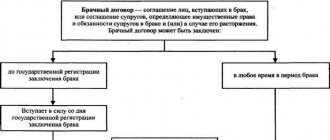28
Russian legislation regulates two types of housing ownership. These include:
- Share. The property is divided among the participants in percentage terms.
- Joint. There is no division into parts, all participants are 100% owners.
The law allows you to change the legal status of housing, from shared to shared. This requires the desire of the owners. Separation occurs through an agreement. If one of the owners refuses to allocate shares, then the procedure is carried out through the court.
General concepts
Expert opinion
Stanislav Evseev
Lawyer. Experience 12 years. Specialization: civil, family, inheritance law.
An agreement on the division of shares is understood as a document necessary to change the form of ownership from joint to shared.
In most cases, joint property arises during marriage, when spouses purchase housing together and have identical rights and identical responsibilities to it. In this case, the property belongs to both the husband and wife 100%, without division into parts.
In addition, unmarried relatives (for example, parent and child; brother and sister) can also be participants in the joint ownership. In this case, the grounds for joint ownership (marriage or kinship) do not matter.
With shared ownership, each participant is the owner of a specific part of the house or apartment, which is determined as a percentage of the entire premises.
Selection methods
There are three ways to divide property into shares:
- Settlement agreement.
- Marriage contract.
- Judicial decision.
In addition, if housing is purchased through family capital, parents are required by law to allocate shares to their children.
Reasons for dividing real estate into shares
In some situations, homeowners come to the decision to divide shares for domestic reasons:
- Unacceptable lifestyle of one of the owners (for example, one of the participants in joint ownership is sick with alcoholism or drug addiction).
- The owners are not close people or are in conflict with each other.
- Co-owners want to have separate property, manage it independently or receive a benefit (sell, lease).
Differences between joint and shared ownership
Citizens sometimes cannot distinguish between the concepts of common joint and common shared property. Even if you read the articles of the Civil Code of the Russian Federation carefully, the meaning of the phrases is identical, but to draw up a legal document it is very important to choose a subtype that is correlated with a specific case.
Subtypes of common property:
- Common property based on the right of joint ownership.
- Common shared ownership.
What's the difference? Everything is very simple. In the first case, the thing initially has the status of a common one without the presence of separate parts. Shared ownership, on the contrary, involves the separation of a certain part from a single object. As an example, consider a shared apartment, which according to the papers is owned by two or more persons. If you look at the document certifying ownership, it will indicate a specific share, for example, ½ belongs to Ivanov, 1/5 belongs to another person, etc. Individuals already have a clear idea in advance of what exactly they can claim when dividing the property.
How to draw up an agreement on determining shares in an apartment
To draw up an agreement, there is no need to contact a notary office, since it is drawn up in simple written form. At the same time, in order to take into account all the nuances, it is advisable to use the services of a competent lawyer.
At the same time, there are situations where notarization of an agreement is mandatory.
| No. | Cases |
| 1 | If the home belongs to the spouses as joint property, in the event of a divorce it must be divided into shares and the transaction must be certified by a notary office. Otherwise, registration of real estate in the Unified State Register of Real Estate will result in a refusal. |
| 2 | If the purchase of an apartment was accompanied by the contribution of family capital, the parents must notarize the obligation to further allocate shares to the children. |
Form and content
The agreement is drawn up in writing using a standard form.
You should start drawing up the document by indicating the following points:
- personal data of the parties (all homeowners are indicated);
- date of compilation and place;
- form of property (apartment, house);
- location of the property (exact address);
- its constituent parts (number of rooms and other premises);
- area in square meters, floor;
- the size of the share for each participant;
- the title documentation is indicated (acquisition agreement, certificate of inheritance, deed of gift);
- certificate of ownership of real estate;
- signatures of all homeowners.
After conclusion, all owners are given their own original agreement, with which they must apply to the unified state registration service (Rosreestr).
Sample agreement
Despite the fact that there is no unified form of the agreement, the general structure is still the same.
A sample of such a document
Drawing up an agreement
An agreement giving the right to determine a part of the common property must be drawn up in compliance with current civil legislation. The division of shared ownership must necessarily be accompanied by notarization.
Now let’s look at the main provisions that are specified in the agreement on the allocation of shares from the common property:
- The preamble of the document indicates the personal information of the future owners of shares in the common property.
- Subject of the agreement. It is considered the most significant part of the contract, since it is in this context that the parties describe in relation to which property the share of joint ownership will be determined. If we are talking about real estate, it is imperative to fully indicate the technical information of the object and the square footage due to each participant in the agreement.
- Rights and obligations of the parties. The distribution of property shares requires a precise indication of the capabilities of each party after the document enters into force. When listing the rights and obligations of each participant, violation of the norms of the Civil Code is not allowed. For example, Article 250 establishes the priority of the interests of the parties to the agreement in the event of the sale of a share to third parties.
- Additional terms and conditions. In this section, the parties can determine the owner who will undertake the notarization of the agreement on the allocation of property that is in common ownership.
Joint property of spouses
The procedure for dividing jointly acquired property is established by the Family Code of the Russian Federation.
The joint property of spouses is the property that they acquired during marriage.
According to the documents, one of the spouses may be the owner of the property, but the property will still be considered joint.
Please note : the right of ownership to jointly acquired property in marriage also belongs to the spouse who, during the marriage, ran a household, took care of children, or for other valid reasons could not work and receive income.
Joint property may include:
- immovable property (apartment, house, land, garage);
- real estate purchased with a mortgage;
- movable items (vehicles, luxury goods, weapons);
- income from work, pensions and social benefits;
- funds in accounts with credit institutions;
- securities.
The common property of spouses does not include:
- property acquired by each spouse before marriage;
- property that the spouse received as a gift or inherited during the marriage;
- personal items;
- exclusive rights to intellectual property results;
- funds received under government programs for specific purposes.
It is important to know: if one of the spouses, at his own expense, makes major repairs or otherwise improves the property of the other spouse, then the court may recognize such property as joint property.
Spouses are obliged to perform any actions with common property only with the consent of the second spouse. If one of the spouses makes a real estate transaction (purchase and sale of an apartment, donation, etc.) and deliberately hides it from the second spouse, then such a transaction may be declared invalid by the court.
What is a share distribution agreement?
The document, the terms of which determine the change in the form of right from general joint to shared, is called an agreement on the determination of shares. The document does not provide a new scope of rights, but clarifies the boundaries within the existing ones. After the distribution of shares in the apartment, it does not become communal, and each participant in the agreement receives the right to participate in the disposal of the property.
The distribution of shares can be carried out in equal proportions to all participants, or with an advantage in favor of one of the owners. As the name suggests, in an agreement, all parties jointly decide how the parts will be defined.
If the basis for obtaining real estate is a privatization agreement, they often adhere to the principle of equality for each owner. When transferring an apartment from state or municipal ownership to private property free of charge, it is considered fair if all participants receive the same shares.
To fix the terms of distribution, it is enough to conclude an agreement in writing without a notarial agreement. The exception is certain cases when there is a requirement to seek the help of a notary (division in a divorce in the absence of a marriage contract or obtaining real estate with the participation of the MSK).
The document is necessary for subsequent registration of ownership rights as common shared ownership. After determining the size of the share, the owner will be able to exercise his right to sell, exchange, donate, or otherwise act with his part of the object. Due to belonging to common property, planning to sell, exchange or rent out your part, you will have to agree on the issue with the other owners of the property.
Determining the procedure for using the apartment
Any of the participants in shared ownership has the right to file a lawsuit to determine the procedure for using the apartment if the co-owners could not reach an agreement among themselves (Article 247 of the Civil Code of the Russian Federation; Part 1, Article 3 of the Civil Procedure Code of the Russian Federation).
In addition, you can go to court with a request to determine the procedure for use if it is impossible to divide the apartment or allocate a share in kind from it (clause 37, Resolution of the Plenum of the Supreme Court of the Russian Federation No. 6, Plenum of the Supreme Arbitration Court of the Russian Federation No. 8 of 07/01/1996).
The statement of claim is submitted to the district court at the location of the apartment
(Article 24, Part 1, Article 30 of the Code of Civil Procedure of the Russian Federation).
When resolving the requirement to determine the procedure for use, the court takes into account (clause 37, Resolution of the Plenum of the Supreme Court of the Russian Federation No. 6; Plenum of the Supreme Arbitration Court of the Russian Federation No. 8; Appeal ruling of the Moscow City Court dated 03/04/2020 in case No. 33-9973/2020):
• the actual procedure for using the apartment, which may not exactly correspond to the shares in the common property right; • the need of each of the co-owners in this apartment; • real possibility of sharing.
In some cases, the court refuses to satisfy the stated requirements. This is possible, for example, if the procedure for using the apartment between the co-owners has not worked out, the plaintiff does not live in the disputed apartment, the size of the living rooms is disproportionate to the shares belonging to the parties to the dispute, and the determination of the procedure for use will lead to a significant infringement of the rights and legitimate interests of other owners (Appeal Determination of the Moscow City court dated January 20, 2020 in case No. 33-2252/2020).
If it is not possible to provide a participant in shared ownership for living with a part of the apartment commensurate with his share, then he may demand that the other owners of the apartment pay appropriate monetary compensation.
Depending on the circumstances of the case, a demand may also be made to remove obstacles to the use of residential premises (clause 2, article 247 of the Civil Code of the Russian Federation; Determination of the Judicial Collegium for Civil Cases of the Supreme Court of the Russian Federation dated November 13, 2018 N 18-КГ18-186; Appeal determination Moscow City Court dated November 26, 2019 in case No. 33-52977/2019).
Registration procedure
In itself, the agreement on the division of shares has no legal significance until the signatories have applied to the registration authority to change the form of ownership and enter new data into the register.
The package of documents for registering changes in property rights includes:
- Statement from the owners.
- Personal documents for each of the co-owners.
- Technical and cadastral documentation (real estate passports).
- Extract from the BTI.
- Paid receipt for registration fee.
Changing the form of ownership requires a standard period of time - 10 days. New documents (extracts from the Unified State Register) can be collected from Rosreestr within the next month.
The new form of ownership does not entail actual division, that is, an apartment in common ownership will not become communal. Receipts for payment of housing and communal services, as well as property taxes, arrive at one address.
After the shares in the real estate are determined, each owner has the right to decide how to dispose of the property, but in most cases, actions require coordination with the other owners (exchange, rent, sale). Restrictions on bequests and gifts do not apply.
If you need to sell a share to an outsider, one month before the scheduled transaction, one of the owners offers to buy out his part of the property to the other owners within the framework of the preemptive right in accordance with Art. 250 Civil Code of the Russian Federation.









